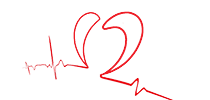Supraventricular Tachycardia - Arrhythmias in the Upper Chamber of the Heart

SVT (supraventricular tachycardia) is a general classification of heart rhythm issues that occur in the upper part of the heart (the atria). As with other heart rhythms, SVTs occur because of a disruption in the heart’s normal electrical rhythm. Symptoms may include heart palpitations, light-headedness, dizziness, shortness of breath, fatigue, or passing out.
Atrial fibrillation (AFib) is the most common SVT, but there are several other types including AVNRT, AVRT, atrial flutter, and atrial tachycardia.
Atrioventricular Nodal Reentrant Tachycardia (AVNRT) is caused by an extra electrical pathway in the heart called the slow pathway. In normal sinus rhythm, a single electrical pathway goes from the upper chamber to the lower chamber of the heart. During an episode of AVNRT, the extra pathway or slow pathway allows electrical impulses to travel in both directions continuously, which can cause the heart to beat 150 to 250 times per minute. In this type of SVT, the extra pathway or slow pathway is located within or extremely close to the atrioventricular (AV) node of the heart. AVNRT is the most common type of SVT, accounting for about 60% of non-AFib cases.
Atrioventricular Reentrant Tachycardia (AVRT) also occurs due to an extra pathway between the upper and lower chambers of the heart, which is referred to as an accessory pathway. In AVRT, just like AVNRT, the accessory pathway allows electrical impulses to travel in both directions continuously, which can cause the heart to beat 150 to 250 times per minute. This is often referred to as Wolff-Parkinson-White Syndrome. AVRT accounts for approximately 30% of non-AFib SVT cases.
Typical atrial flutter is also a type of reentrant arrhythmia where an electrical impulse continues in a circular pattern in the right atrium. This causes the atria to beat at approximately 300 beats per minute while the lower chamber of the heart continues to beat at a much slower rate, between 75 and 150 beats per minute. Atrial flutter is often seen in patients that have atrial fibrillation as well.
Atrial tachycardia is a heart rhythm issue in which the electrical impulse comes from an ectopic pacemaker (or specific group of overactive cells) in the upper chamber, rather than from the sinus node where electrical activity typically originates. Atrial tachycardia can cause heart rates ranging from 140 to 220 beats per minute.
All of these SVTs are diagnosed through an assessment of the patient’s symptoms and evidence of the arrhythmia through an ECG, as well as a wearable heart monitor for at-home monitoring, if needed.
Many SVTs can be treated with prescription medicine, such as beta blockers or calcium channel blockers, to lessen the frequency of the arrhythmia. However, most patients with SVT choose an ablation to cure the arrhythmia rather than simply reduce the occurrence. Most non-AFib SVTs can be treated with ablation, which uses radiofrequency (heat) or cryo (freezing) ablation techniques to eliminate the electrical activity of the extra pathway or tissue. AVNRT and AVRT do not increase a patient’s risk of stroke, but atrial flutter and atrial tachycardia do carry an increased risk of stroke and will require blood thinners to reduce that risk.
If you are experiencing periodic heart palpitations, dizziness, or lightheadedness, contact the Oklahoma Heart Hospital today to schedule an appointment.




